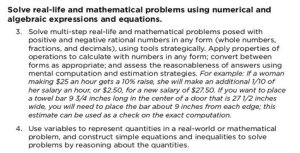Assessing the Common Core Standards: Real Life Mathematics
Another buzzword that permeates the conversation around education is relevancy, and rightfully so. We want our students not only to make connections to real-world problems but also to do these activities.
However, it is not simply in the task that we want students to mimic real world connections. Students are already conditioned to do this. They are used to sitting and completing tasks. Even when the task might have great connection to the real world, it can still just be that: a task to complete. We need to keep this in mind when we ask students to perform real world math, just as the Math Common Core dictates.
Taking a Closer Look
The following Common Core standard gives a great example and sets a solid tone for what can be targeted in math instruction:

In a previous blog discussing Math PBL Project Design, I wrote about reframing the word "problem," and pointed to this standard. For many of us, there is a very traditional meaning that is activated: a word problem in the text book, or simply a calculation to be made. In fact, the Common Core gives it as an example.
We can do better. We can assess learning in a much more relevant and engaging way. For instance, how do we assess this Common Core standard related to area and volume?

This standard is much less specific about what this might "look like" in the classroom, which leaves it ripe for innovation. There are a variety of products and contexts that could assess this standard. The major assessment, or culminating product in PBL terms, could take on the form of a podcast, presentation, marketing plan, or even a short story.
Other ways to assess this standard in imaginative, real-world scenarios:
- High school students are creating a swimming pool that can meet the needs of all people who want to use it -- from those who have special needs to children -- and at the same time needs, it meets certain criteria in terms of standard amounts of water and size.
- Middle school students are in charge of designing a new and improved pyramid to be presented to the pharaoh, complete with a variety of antechambers.
- Elementary students are in charge of creating an organic garden to sell certain products at the local farmer's market.
Criteria and Rubrics
A word of caution, don't give students the exact criteria, instead make them research and make decisions on what the criteria should be.) Again the genre is not as important as the rubric that demands specific criteria. As long as the rubric is clear and transparent where students must demonstrate math skills, include examples, etc., then we know that students are in fact learning and applying the Common Core standard.
If you as the teacher need a specific graph, then make sure to include in the rubric. If you need written explanation around the mathematical calculations, then demand it. If you need diagrams and measurements, then make sure the rubric demands it. Grading is not a surprise anymore. It is clear and transparent.
When looking at the potential for work with this Math Common core, make sure you have high expectations for the level of work your students can do. The old definition of the word "problem" is not rigorous. Redefining the word "problem" within the frame of Problem or Project-Based Learning is rigorous, and still demands real world connections in an authentic way.
If we want our students to really wrestle with math concepts, then we must create space for this work to happen, and create assessments that mirror this complex work.
